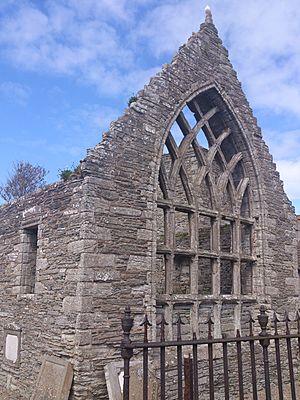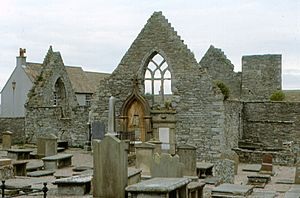Old St Peter's Church, Thurso facts for kids
Auld St Peter's Kirk is an old, ruined church located on Wilson Lane in Thurso, Caithness, Scotland. It is named after Saint Peter and is very old, dating back to at least 1125. For a long time, it was the most important church in the area. Bishops of Caithness looked after it. Since 1929, it has been a protected historical site called a scheduled monument. From 1975 until 2016, it was also a Category A listed building, which means it was considered a very important historical building.
The Church's Story
The church in Thurso is dedicated to Saint Peter. Records show it was an important church for the Bishop Gilbert in the past. In the 1500s, different church leaders, like Sir John Mathesoun and Master John Craig, were in charge of the church. Master Walter Innes was the vicar of Thurso in 1560. Later, in the 1600s, Alexander Monro, a minister, received money to help with his church work from the Thurso area.
Old St Peter's Church is still standing today, but it hasn't been used for church services since 1832. That's because a new church was built for the area. The new church, called St Andrew's and St Peter's, was designed in a Gothic style by William Burn.
What the Church Looks Like
The church has a cruciform shape, which means it's shaped like a cross. It was built in a "pointed style," which refers to its architectural design. A record from 1726 mentions that above a room at the east end of the church, there was a meeting room for the church leaders. This room was also used by the local sheriff and judges as a court and even a prison. Above another small room, there was a bell tower with a public clock. The church no longer has a roof and was built using local stones.
The Church Grounds
The old church is located on the left side of the River Thurso, very close to the sea. It is surrounded by a wall made of stone slabs. In 1786, people complained that trash was being dumped on the graves in the churchyard. More recently, in 2013, some gravestones were knocked over and broken.



